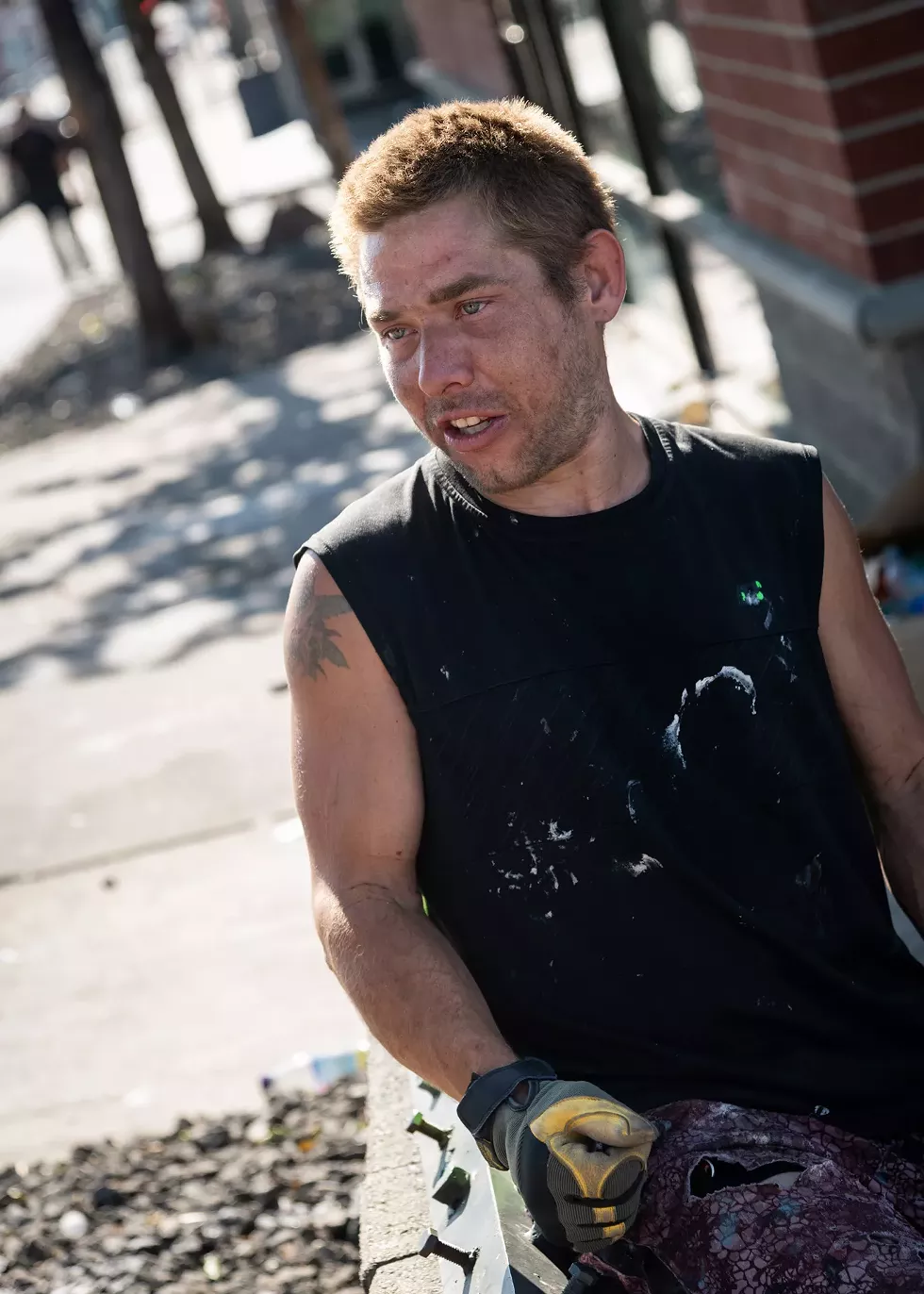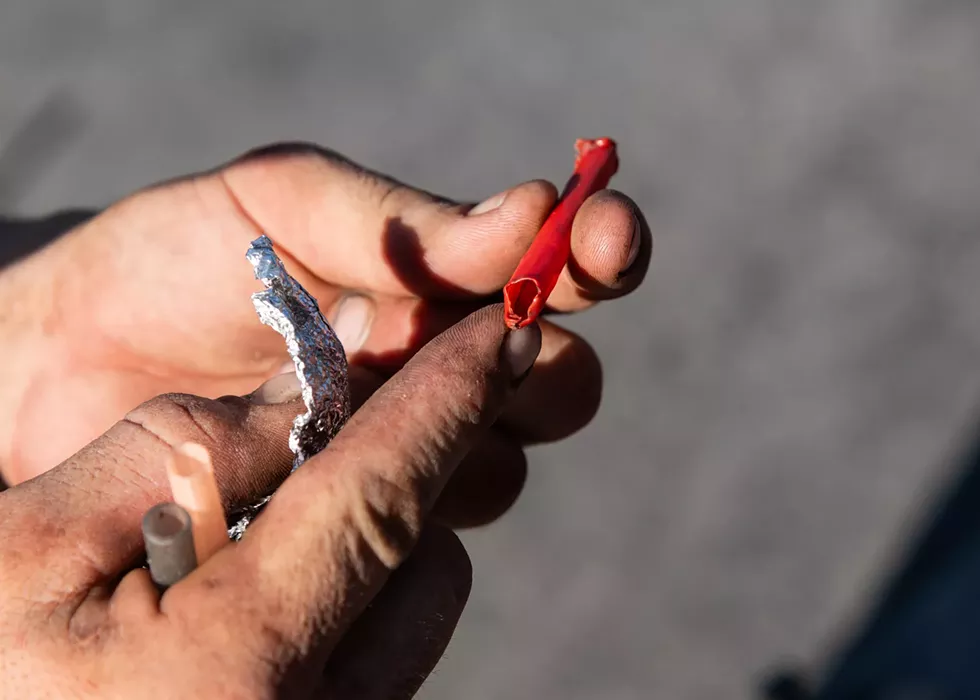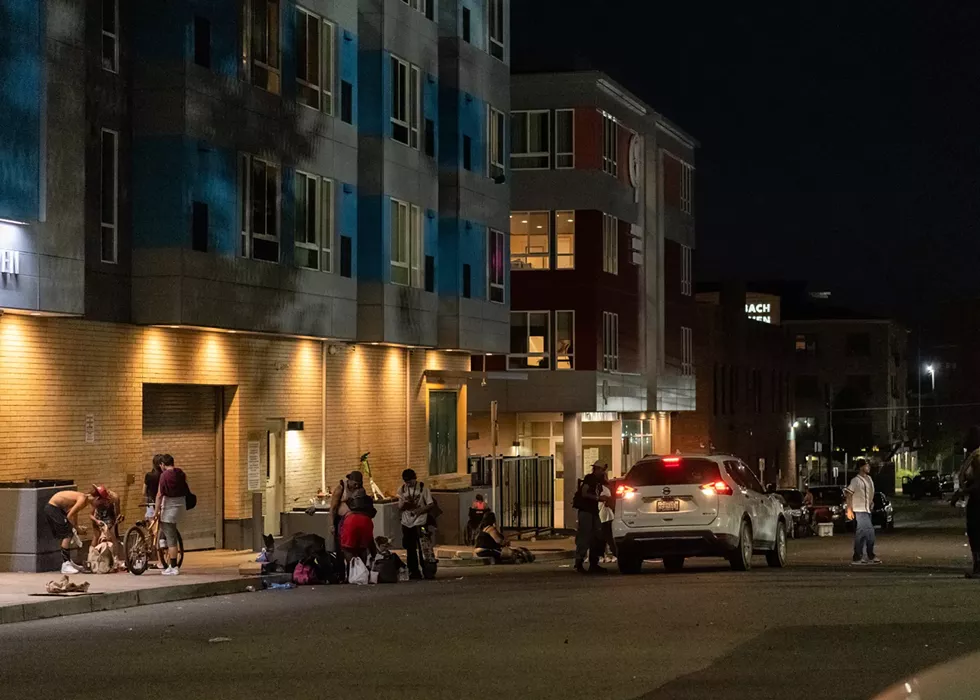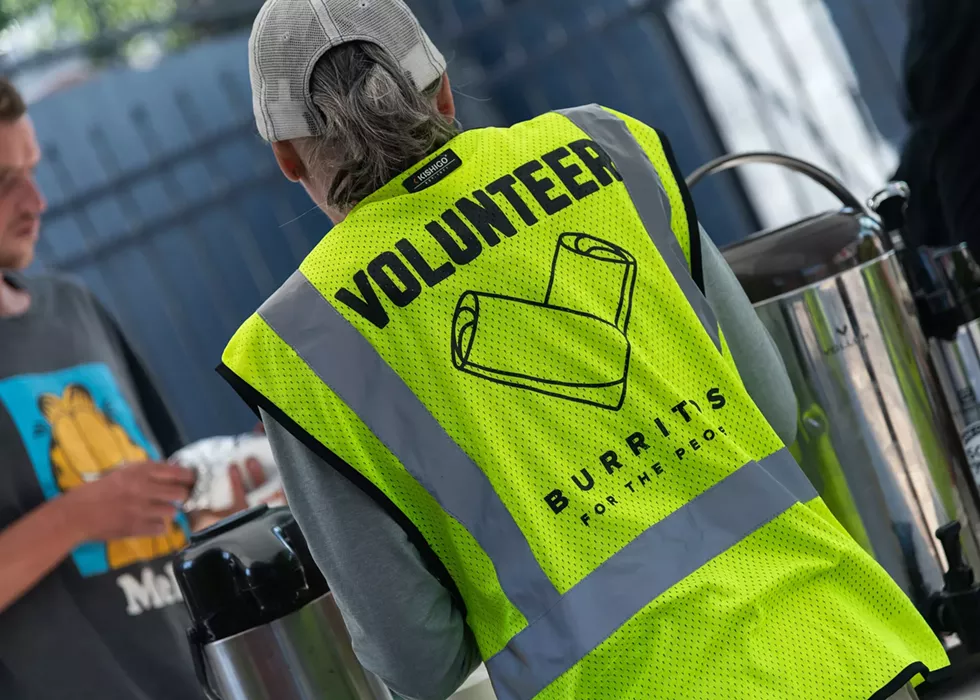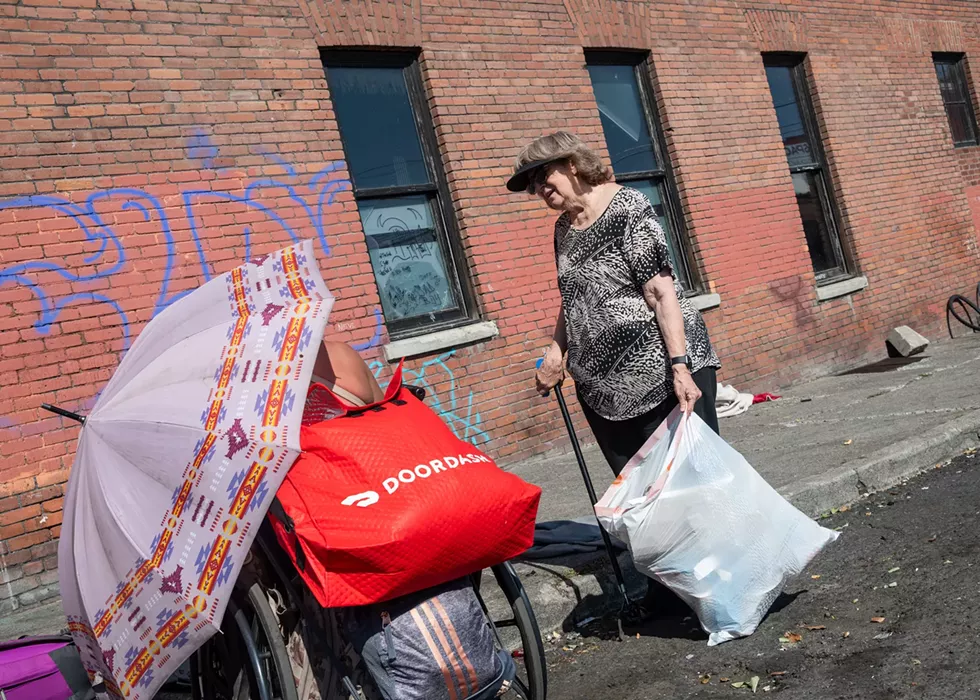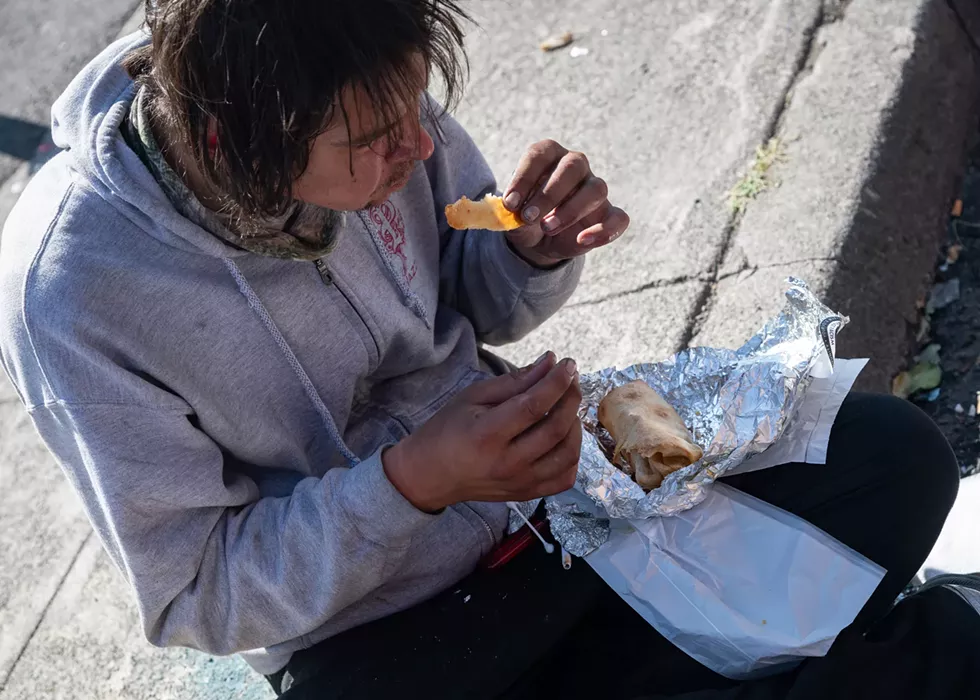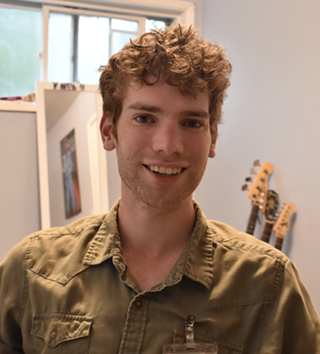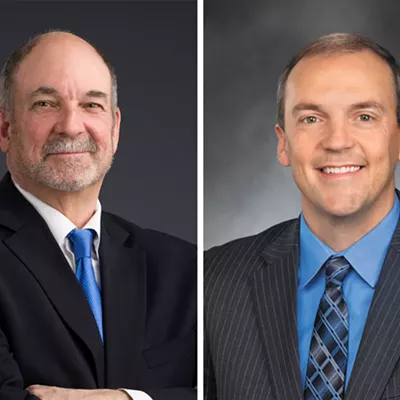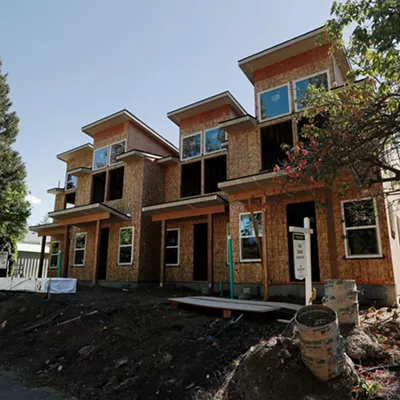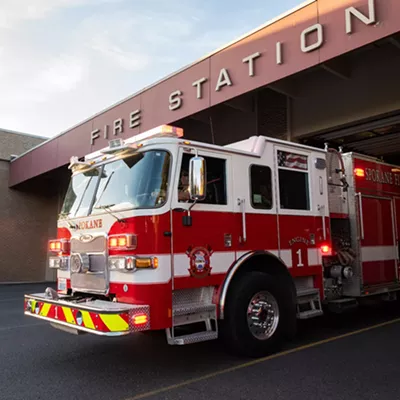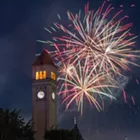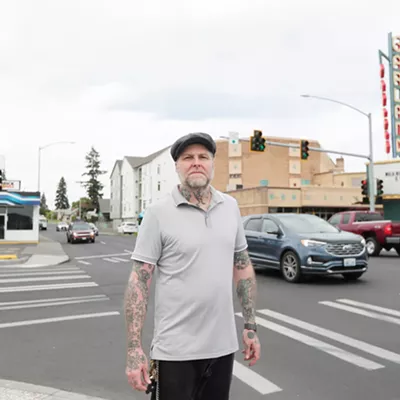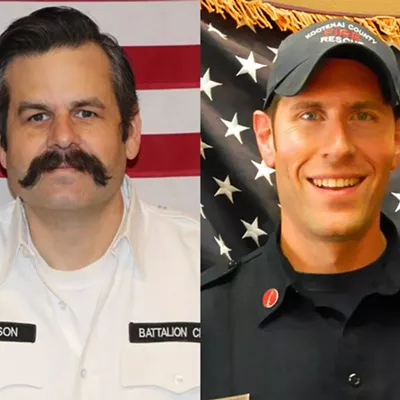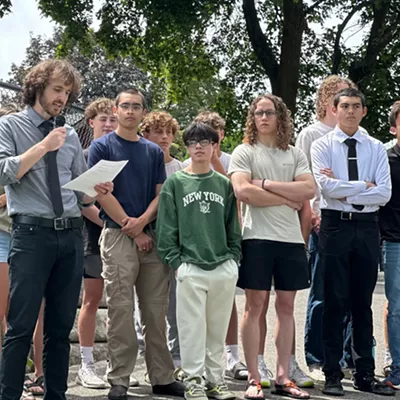
The intersection of Second Avenue and Division Street in Spokane has a reputation.
It's a major thoroughfare, just a few blocks from the downtown core. It's the first thing many visitors see after exiting the interstate, and one of the most heavily-trafficked parts of Spokane, with more than 30,000 cars passing through each day. Mayor Nadine Woodward describes it as "the main gateway into our city."
It's also the epicenter of a humanitarian crisis.
Suffering is everywhere and impossible to ignore. People in torn clothes and visible states of distress wander the area at all hours, looking lost. Screams and fights echo through the night. Fentanyl is smoked in the open or under blankets to block the wind. It's a hotspot for overdoses, and a frequent backdrop for evening TV news segments about drug arrests or local businesses fleeing downtown.
A Starbucks on the northwest corner closed last year. A church across the street said in February it was moving out but hasn't yet been able to sell the building.
The area is also a hub for social services. There's an addiction treatment center, a low-barrier shelter and several supportive housing complexes within a couple blocks.
Woodward says the city is cracking down. She points to two city laws: a revived rule that prevents sitting or lying on public sidewalks, and a new one that makes public drug use a misdemeanor.
Citywide, police issued 12 sit/lie citations this May and June combined. Seven were within a couple blocks of this intersection. The department conducts regular drug emphasis patrols in the area. During the last one, they made 17 arrests in one day.
The area has long been troubled, and residents say the problems come and go in cycles. But over the past three years — as pandemic, fentanyl and housing crises ripped across West Coast cities — the intersection has been looking worse for wear. A small sliver of a societal emergency decades in the making.
We spent one weekend in late July at the intersection, talking to the people who live and hang out there. This isn't a story about homelessness, or the state of the world. It's a snapshot of one intersection, on one summer weekend, in a city in the middle of a crisis.
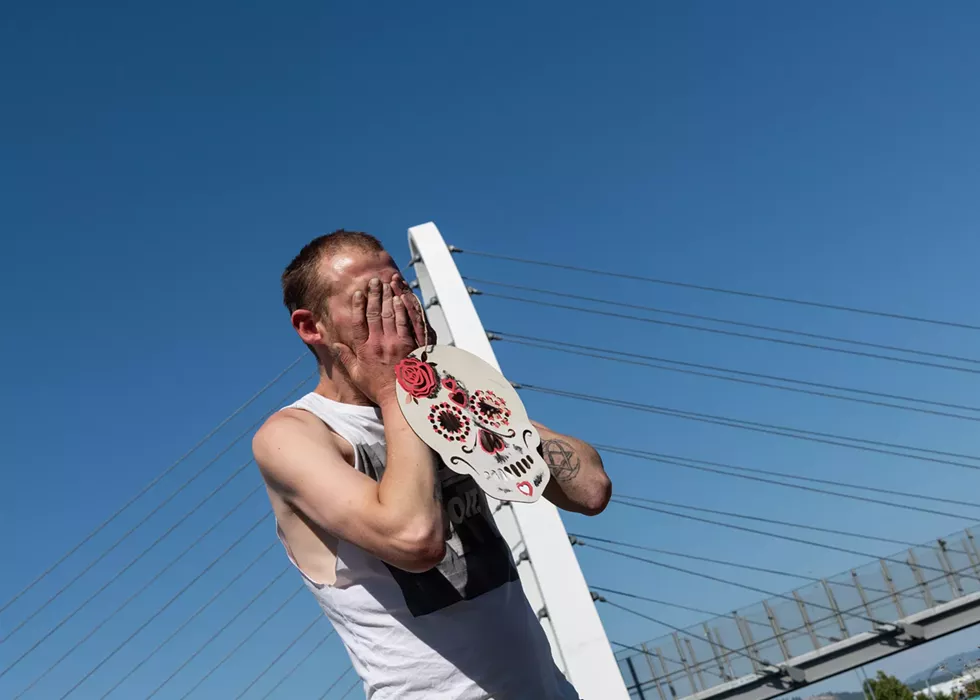
GOD'S CITY
Space Jam, a homeless man who often stays in the area and asks to go by his nickname because of active warrants, is well aware of the stereotypes. He says he's heard this described as the "most dangerous, most rundown, most drug addicted, most crime f—-ing" filled part of town.
"What's your guys' goal today?" he says, shortly after asking if we're tourists who got lost. It's midafternoon on Saturday, July 29. "Are you trying to show the vibrancy in the dimission of society?"
Space Jam says he came to Spokane from Olympia about five years ago while trying to avoid legal trouble involving a stolen car. He describes growing up with mental illness stemming from a traumatic brain injury in an abusive home and says he was pulled into a gang lifestyle as a teenager living on the streets.
Space Jam, 34, says he's staying away from all that stuff now. Falling in love with music and moving to Spokane helped give him a new outlook, he says.
"This is God's city," Space Jam says. "Where sinners become saints."
Damon Trinkle is hanging out in the parking lot of the former Starbucks. He's a chatty guy, and cracks jokes about how "shady" we look loitering from the sun under a tree.
Trinkle lives with his mom in Spokane Valley and sometimes works painting jobs. He says he has friends who live near this intersection and comes down here fairly often to say hi and make sure they're still alive. He also visits to buy fentanyl.
"Don't judge me because I sin differently than you do," Trinkle says.
The drugs are taking a toll on Trinkle's home life. He says he'd like to quit. But not today. It feels good, he says — like a full body massage.
Trinkle says people call the fentanyl pills "blues," "beans" or "mexis." The rainbow-colored pills are less common and are often called "Skittles," like the candy. You can't really find heroin in Spokane anymore without knowing the right person, Trinkle says. But fentanyl? It's everywhere. Ask anyone. Three or five bucks a pill. It'll cost more if you want raw powder.
People used to sell drugs by the 7-Eleven, Trinkle says, but moved down the street after police started cracking down a couple months ago.
"The drug problem is pretty bad, I'm not gonna lie to you guys," Trinkle says.
BUYING BEANS
An older man with a Seahawks baseball cap and a bushy gray beard has been sitting on the northeast corner of Division and Second all afternoon, scanning the street from behind a pair of reflective sunglasses.
He says his name is Don Fuller, and that he became homeless a few months ago. His wife left him, and his life "spun out of control." He describes struggles with bipolar and post-traumatic stress disorders. He has a plastic box of sandwiches and says he's trying to sell them so he can afford a room at the La Quinta Inn across the street for the night. The hotel is bordered by an imposing, spiked metal fence.
“It’s a mess man. People are robbing out here. They’ll rob you. I’ve been jumped.”
"It's a mess man," Fuller says of the intersection. "People are robbing out here. They'll rob you. I've been jumped."
While we're talking, Trinkle approaches Fuller from behind, just out of his line of sight, and Fuller startles — his hand twitches toward a bag resting by his side.
"Don't f—-in' do that man," Fuller says. "Motherf—-ers come up behind me, I don't know what they're going to do."
Trinkle apologizes profusely. He didn't mean to scare him.
"Just don't do it again homie," Fuller says.
Trinkle somehow managed to pull together $3. Fuller tells me to take a walk. "I've gotta do business with this guy," he says.
I leave them alone. When Trinkle reappears a few minutes later, he has a small blue bean in his hand. He asks if we would like to watch him smoke it.
POSITIVE IMPACT
There's a treatment center a couple dozen feet away, called Compassionate Addiction Treatment. It has 15 staff members and offers case management, medication-assisted treatment, a drop-in day program and other services.
Space Jam says the peer counselors there have been helping him avoid drugs.
"Oh man, they have no judgment. They're beautiful," Space Jam says. "CAT needs more money to help people."
Hallie Burchinal founded the center in 2019. She says CAT largely relies on private donations and a maze of grants to fund the work. Medicaid helps with some services, but it doesn't cover everything, which means the organization often bleeds cash, Burchinal says.
The center moved to the Division Street location in spring 2022. It's been an uphill battle ever since.
"The work is hard, just because it's emotional and heavy," Burchinal says. "But it's the politics that are just truly what feels the most soul crushing."
CAT and other nearby service providers are regularly accused of drawing people to the area and contributing to the overall sense of disorder and safety issues on the streets. Just one month after moving in, police delivered CAT a letter informing the center that it'd been identified as a potential chronic nuisance.
Woodward says she's talked with CAT about its impact on the neighborhood, and that she doesn't think it's been positive.
"We need to create the expectation that if you're a service provider, and you're working with our unhoused, your work cannot lead to trash on the street, to people loitering, hanging out, victimizing the community or businesses," Woodward says. "That's what we're seeing. The graffiti, the property crime, the garbage, all of that."
Burchinal pushes back on the idea that CAT and other services are drawing people to the neighborhood. She thinks the city often pushes unhoused people to the neighborhood from other parts of downtown because there aren't as many businesses. She recalls experiencing a similar thing when she was homeless in downtown Spokane in the 1980s.
"They seem to want us to kind of police the neighborhood around our building," Burchinal says. "We don't have the human resources to do that, financially."
It's a challenge that Catholic Charities is also familiar with. In addition to House of Charity, a 135-bed, low-barrier shelter with minimal entry requirements a couple blocks from the intersection, Catholic Charities also operates five permanent supportive housing buildings in the neighborhood.
The 50-unit housing projects, called "havens," offer peer-support and other services that aim to help residents stabilize their lives. Many of the people in those units work jobs and pay a portion of their income toward rent.
The havens are an example of the "housing first" model, which prioritizes housing over sobriety or other requirements. Woodward doesn't think it's working. She wants to see a more dispersed approach to services going forward.
"Having a night-by-night shelter right next to their housing first developments has not been a positive thing for people in the shelter or people in the havens," Woodward says.
Tension over Catholic Charities' presence in the area isn't new.
Kelly Keenan, vice president of advancement and impact at Catholic Charities, says the organization hears the complaints, but he says the people they see contributing to illegal and unsafe activity on the streets aren't their clients. Sometimes, Keenan says, people are coming to the area to prey on the people staying at the havens, many of whom are actively working to beat addiction.
Keenan says Catholic Charities has a 20-person safety team that regularly patrols the sites. They also collaborate with law enforcement and work on trash pickup.
"We believe that individuals who are contributing to the disruption of services and community safety should be appropriately engaged by law enforcement as soon as possible," Keenan says.
The mayor has been trying to get House of Charity moved out of downtown for years. Conversations are ongoing. Keenan says they still haven't found a location.
Burchinal says her treatment center isn't going anywhere.
"Even though it's hard, it's exactly where we belong," Burchinal says.
'I DIDN'T KNOW I WAS DEAD'
Trinkle seeks shelter in the shade of the former Starbucks. He's joined by a buddy he met earlier today who asks to go by his street name: Justin Time.
"It's better to smoke in pairs because if you do overdose, somebody's there to send help or something," Trinkle says.
"I usually carry Narcan, but my bag got stolen this week," Time adds.
Narcan is the brand name for naloxone, a drug that can be sprayed up someone's nose to block their opioid receptors and — hopefully — reverse the effects of an overdose and save their life.
Trinkle says he's been Narcan-ed about 10 times. It's not pleasant.
"You come out of it and you're like, what the hell just happened?" Trinkle says. "It felt like I was sleeping. I didn't know I was dead."
Time carefully loads the blue pill onto a piece of tinfoil, heats the bottom with a butane torch lighter and inhales the smoke with a metal coffee straw. It's healthier than the plastic straws, he explains.
When it's Trinkle's turn, he dives right in with a plastic tube taken from a dismantled pen. Most people call the straws "tooters," but Trinkle says he prefers a "hooter."
When we talked earlier this afternoon, Trinkle was bright, charismatic and genuinely funny. It disappears when he hits the foil.
He slumps over, staggering around and waving his arms erratically. He can barely stand up. He's mumbling and semi-coherent, but he just keeps going. He hits the foil again and again and again.
Time is still lucid — he only had one hit. As Trinkle lies down on the sidewalk, Time tells me about his experience with homelessness in Phoenix, and how he moved to Spokane last December after his aunt heard he was sleeping rough and invited him to stay with her. They recently had a falling out, and now Time is back on the streets.
Trinkle opens his eyes and jolts into an upright position — fumbling for the foil to take yet another hit. I think about his 10 overdoses and want to plead with him to stop, but Time insists that he knows what he's doing.
"He's alright, it's pretty normal," Time says.
Trinkle takes another puff and slumps back down on the sidewalk.
Eyes closed. Full-body massage.
EPIDEMIC
Spokane's Fire Station 1 is a half-mile away from the intersection. None of the firefighters working there are surprised when I tell them I met someone who continues using after overdosing 10 times.
"We go to the same people most of the time," says Mike Walker, a lieutenant with the department.
Engine One, a single firetruck stationed downtown, has responded to 219 overdose calls so far this year. Firefighter Sean Champoux estimates that at least 95 percent were fentanyl-related. By contrast, the engine responded to 159 this same time last year, and 207 in all of 2021.
The firefighters say they sometimes respond to multiple overdose calls for the same person during a single shift. They say the Havens, 7-Eleven and House of Charity are all hotspots.
Corey Barker, another firefighter, remembers getting calls for alcohol overdoses when he started with the department 25 years ago. Then heroin. Then meth. Now it's fentanyl, which far outpaces the devastation of previous drugs.
"The ease of access to fentanyl is just crazy," Barker says.
Over the past year, overdose deaths in Washington increased by 21 percent, outpacing every other state in the nation. In Spokane County, 147 people died of fentanyl-related overdoses last year, a 425 percent increase from 2020.
"People are dying at astronomical rates, we need to do something," Woodward says. "We need to start taking drastic measures to save people's lives."
Burchinal says it used to be really traumatic when her staff had to use Narcan on someone overdosing outside the treatment center. Not anymore.
"For our team, it's just part of the normal daily thing now," Burchinal says. "They don't even think about it."
Fentanyl's affordability, potency and ease of access make it especially hard to combat, says Misty Challinor, a treatment services division director at the Spokane Regional Health District. The drug literally changes the way your brain works. Stigma, trauma and grueling withdrawals can make quitting feel nearly impossible, Challinor says.
"It's essentially like having the flu for several weeks or months," Challinor says. "But it's the flu times 100."
NIGHT
As darkness falls, Fuller stays at his perch on the northwest corner. People come and go. A woman without a shirt drags a plastic chair across the street as a stream of cars swerve to avoid her.
A shouting match breaks out in the 7-Eleven parking lot, but the quarrelers walk away before it gets physical. The entire lot is watched by a mobile security unit with speakers and cameras on a raised pole. Someone smashed one of the solar panels, but the machine still seems to be working.
"Thank you for shopping at 7-Eleven," the machine says. "For your safety, the parking lot is being video and audio recorded."
On the sidewalk outside Donna Hanson Haven, a couple huddle together and watch a movie on a cellphone.
A young woman sticks her head out of a car driving down Second Avenue and yells, "Tweakerville!"
“When you drive through this neighborhood, you’re seeing reality.”
It's an attitude Burchinal has encountered before. People don't like seeing things that make them uncomfortable, she says.
"When you drive through this neighborhood, you're seeing reality," Burchinal says. "But rather than being angry because it makes them uncomfortable or it's upsetting to see, I wish people would drive through and see the need that's going on there. The need for better services, the need for change, the need for housing, the need for improving our foster system."
Burchinal stresses that substance use disorder is often tied to untreated trauma, and that multiple studies have shown housing costs — not drugs — are the primary cause of homelessness. Addiction, Burchinal says, is often the symptom, not the cause.
'ONE TIME'
The next morning, a pair of police officers are detaining two men outside the former Starbucks. It's 8 am, and the air is already thick with heat.
Fuller, who sat in the same spot yesterday with a box of sandwiches, is back on the northwest corner, a couple dozen feet from the cops. Time is standing with him, and they're watching the arrest with a mix of disappointment and exasperation.
"He's gonna go to jail," Time says.
"They caught him red-handed," Fuller adds, shaking his head.
Time and Fuller had tried to warn the men. When they saw the police rolling through, they shouted "one time," which is code for cops. But the men smoking fentanyl on the sidewalk didn't listen. Now their drugs are in a plastic evidence bag, and their hands are in cuffs.
A 59-year-old man who asks to go by his nickname, Sergeant Prime Time, wanders over to watch the arrest.
Prime Time says he's been homeless for about five years and recently lost his ID. He says he comes to this area because there's free food and water. There's also the 7-Eleven, which takes food stamps. He used to stay at House of Charity, but says he got kicked out after getting in a fight with someone who was eating crackers and spilling crumbs on his bed.
Prime Time doesn't use drugs. But he understands why so many on the street are drawn to it — even the really destructive stuff like fentanyl.
"Drugs help them deal with life," Prime Time says. "But when they come down, they still got the same problems."
Prime Time doesn't think arrests help. Fentanyl is dangerous, he says, but the people outside the former Starbucks weren't hurting anyone but themselves.
Almost every major city in Washington has spent the past two years grappling with that argument.
In 2021, Washington's Supreme Court ruled that the state's drug possession law was unconstitutional, and lawmakers passed a temporary stopgap measure that effectively decriminalized most types of drug possession. After the state Legislature failed to agree on a replacement ahead of the measure's expiration this spring, cities across the state, including Spokane, scrambled to pass their own drug use laws.
It was a heated, emotional debate. Almost everyone agreed that the status quo wasn't tenable, but the legacy of the War on Drugs loomed large, and advocates worried that a return to criminalization would only make things worse for people struggling with addiction. Others argued that jail could help connect people with services.
In May, Spokane passed a law that made public drug use an arrestable offense. If police see someone using drugs in public, they can choose to either arrest and take them to jail, or release them with a citation for community court.
Julie Humphreys, a spokesperson for the police department, says officers use discretion and consider factors like jail capacity, officer staffing and the circumstances of the individual when deciding whether to release someone with a citation or arrest them.
"If there's no demand, sellers won't have anyone to sell to," Humphreys says. "People are addicted, and we're trying to protect them."
Humphreys says 123 people have been cited or arrested under the new law since it went into effect in May. She wasn't able to provide a specific breakdown on how many of those 123 people were cited and released versus how many went to jail, because the department's data system has them together in the same category.
During a special session called by Gov. Jay Inslee this spring, the state Legislature passed a law making possession a misdemeanor. Humphreys says she expects to see the number of arrests and citations increase once Spokane police start enforcing it at the end of the month.
The people watching the arrest on Second and Division are familiar with the basics of the legal situation.
"It's the governor's idea — the governor came up with that crap," Fuller says.
Time has a couple buddies who've been arrested for public drug use in recent months. He says they came out of jail a week later with a lower tolerance and started using again.
A third police car pulls up and escorts the men into the back of a car. You can hear muffled music from the church across the street.
"Boy, I'd sure love to see the mayor's face right now," Fuller laughs. "She's probably loving this."
I ask Fuller where the drugs are coming from, and he waves the question away. Don't talk about that stuff, man.
A few minutes later, a voice echoes down the street as another police car rounds the corner.
"One time, one time."
BURRITOS
A line is forming outside Compassionate Addiction Treatment. They're here for Burritos for the People, a weekly free breakfast program run by Spokane Community Against Racism, or SCAR.
For more than two years now, volunteers have come out here every Sunday morning to hand out coffee, juice, water and breakfast burritos to whoever needs it. The volunteers also pick up trash in the area. They serve about 300 burritos each Sunday.
"It's a drop in the bucket for what's actually needed," says Scott Mueller, a volunteer with SCAR. "But it means a lot to folks to have a little bright spot."
Volunteers in reflective vests hand out water and manage the line. The atmosphere is light. The food smells great, and the volunteers are quick to share smiles with the guests.
Justice Forall, an organizer with SCAR, says the group doesn't consider itself a homeless service provider or mutual aid group. People involved with SCAR are just doing what they can to help people out. For many people living outside, the weekly burrito handout is one of the only safe places they have, Forall says.
In the parking lot outside the treatment center, Mueller's mom, Margo, is picking up trash with a grabber tool. She comes out here to help with trash pickup every week and says she gets a lot of joy out of the relationships she builds with the people she helps.
"You cannot imagine how nice they are in return," Margo says.
SICK AND TIRED
Time is sitting on the sidewalk outside Donna Hanson Haven and eating burritos with his buddy, Elliot Morrison.
Morrison says he came here from Tacoma in February because his friends had convinced him to try getting clean at a local rehab center. But he wasn't ready and left after a few days. He and Time smoked fentanyl earlier this morning.
Time says he's still moving his stuff out of his aunt's place and isn't sure where he'll sleep tonight. Morrison recommends House of Charity, and Time says he'll think about it.
"It's a good place, man," Morrison says. "They have food and stuff."
But Morrison says he doesn't stay at House of Charity anymore himself. They can be strict about drugs, and he worries about being stuck there at night after the doors are closed and getting sick from withdrawals.
Morrison says his addiction started with heroin. He was clean for a while, but relapsed after his mother died two summers ago. He says the fentanyl he uses now is a lot more addictive and comes with a tougher comedown.
Morrison says he stole from a tip jar at a Starbucks across town a few days ago. He feels really shitty about it, but says the desperation was overpowering.
"I definitely never saw myself... I don't think anyone sees themselves doing stuff like this," Morrison says.
Morrison doesn't plan on staying in Spokane much longer. He wants to go back to Tacoma before the winter, because he's heard they have a program that places homeless people in hotels while they're on the waitlist for more permanent housing.
I ask Morrisson if there's anything he wishes people knew about what it's like out here.
"Everybody has a reason for addiction," Morrison says. "It's not just like, 'Oh I want to get really high all the time.' It's usually to mask something or cover something up. Your brain makes you think you need it, you know? And at a certain point it stops being fun."
Time nods in agreement.
"Eventually, you beat it," Time says. "You get sick and tired of being sick and tired. Or you die."
HEARTBROKEN
I went back to the intersection one week later, on an overcast Sunday morning in early August, to follow up with Mueller with some questions.
Shortly after I arrived, Forall, the organizer with SCAR, was physically assaulted while trying to ask a man outside Compassionate Addiction Treatment to smoke elsewhere.
I was in the building's parking lot talking to Mueller when the shouting started. The man was agitated about Forall's request, and seemed to be mentally unwell or in some sort of crisis.
After a few minutes of yelling, something snapped and suddenly Forall was on the sidewalk trying to protect their face as two men rained down punches. It was chaos. People in line for burritos yelled at them to stop and ran over to intervene. Someone called the cops. Mueller tried to pull the men off, and he, too, ended up on the ground under a hail of fists.
The attack ended as quickly as it started. Forall and Mueller walked away a little bruised and shaken up, but otherwise OK. Nothing like that had ever happened before, Mueller said.
Police arrived 20 minutes after the 911 call went out. Three squad cars. The assailants were long gone at that point, but Mueller and Forall weren't interested in pressing charges anyway. It wouldn't help anyone, Mueller said. He had a painful-looking bruise under his right eye, but didn't seem angry.
"When people are dysregulated and with trauma, weird stuff happens," Mueller said. "We've got a lot of people with a lot of issues, and throwing them in jail is not going to fix that."
Even before the attack, spirits were low that morning.
After two years and about 30,000 free burritos, leadership at Compassionate Addiction Treatment had just informed SCAR that they would no longer be allowed to hand out food on the property. The volunteers have until the end of the month to find a new spot. They're not sure where they'll go.
“We’ve got a lot of people with a lot of issues, and throwing them in jail is not going to fix that.”
Burchinal says the decision stems from increased complaints and pressure from several nearby businesses who felt that SCAR — and a mobile health clinic that also sometimes uses the property — had been contributing to the disorder by drawing people to the area.
Burchinal is hesitant to name businesses or go into detail about the complaints — it's a sensitive situation the organization is still trying to navigate. But she doesn't think getting rid of weekly burrito distribution and the mobile health clinic will do anything to stop people from congregating or causing trouble in the area.
Forall and Mueller say they don't blame the treatment center for the decision. But the news is still devastating.
"This is the place of highest need," Mueller says. "We're heartbroken." ♦

